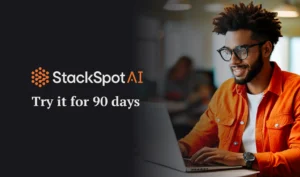In the ever-evolving landscape of a product-led business journey, modernization marks a significant step forward. No matter how your organization is evolving, one thing remains constant: the need for your applications to evolve in tandem. How you navigate adoption and change management can be the linchpin of your success. Here are four essential keys to navigating this journey intelligently.
1. Nurture a Culture of Open Communication
A 2022 survey found that over half of enterprises worldwide were modernizing apps, but that doesn’t mean it’s a sure thing. Encouraging user buy-in poses one of the most significant hurdles to successful modernization. Individuals have invested time in mastering the old system and have built workflows around it. Now, the challenge lies in convincing them that adopting the new system is worth their continued effort.
Maintaining open communication is crucial for building a stronger case. When deployments encounter unexpected challenges, embracing feedback allows for swift adjustments and faster resolution, ultimately enhancing the overall process.
In organizations where clear communication channels are established, taking a firm stance on ownership becomes more feasible. Setting the groundwork early by assigning responsibility for specific processes helps reduce crosstalk and fosters collaboration among users.
Meet our Developer Platform
StackSpot EDP allows for built-in communication by establishing technology stacks, plugins, and starters for specific teams and projects. This fosters a sense of collaboration to define which technologies are to be used in various contexts, and deployment of new standards in real-time.
According to the 2023 Foster research report, companies that adopt EDPs have reduced their time to market by 55%. Enhanced communication and streamlined processes contribute to this improvement.
Lastly, remember that not all mission-critical communication happens internally. One 2023 study revealed that 95% of organizations were willing to work with outside modernization partners. Standardizing your communication practices leads to more predictable, dependable vendor relationships — and improves your odds of putting out fires if third parties drop the ball.
2. Equip Teams for the Transition
Provide access to certifications and customized training (e.g. Kubernetes) to inspire continuous learning among development and platform teams.
Training
Your training practices and continued education systems have to be flexible. If you deploy new APIs in the morning, your engineers should be able to start learning them that afternoon — or sooner. If you swap components out of your technology stack, the team shouldn’t have to determine which learning materials to follow — updates should be automatic.
EDPs speed onboarding by standardizing practices and work environments. High level of customization of use of different technologies based on context ensures that engineering teams can maintain best practices and captured learnings from proven workflows, but simultaneously encourages collaborative innovation. EDPs also make it easier for mentors to impart consistent, top-down knowledge.
Empowerment
Give your teams the supportive frameworks they need to adapt. Work with team leaders to identify the factors that impact developer experience and start optimizing there.
Adjusting to change is easier when your work environment accommodates change-oriented practices. Encourage creativity among development teams by reducing the fear around experimentation. Standardized testing and automated application of technology stacks will reduce developers’ cognitive load and spur innovation.
Automate the processes to create new sandbox environments and develop unit tests to allow more time for ideation.
3. Monitor and Measure Change Success Metrics
What are the current objectives for your initiative? For example, a deployment of a new mobile application leveraging microservices. How are you measuring continued performance once you reach your goal?
Monitoring change success metrics helps quantify this journey, but it’s more complicated than it sounds: 29% of project managers say picking the right KPIs is one of their biggest hurdles.
Supplementing your technical measures with humanistic metrics is a great start. For instance, if you deployed a new cloud service, you’d benefit from looking at how much money it saved. But why stop there when you could also measure technology utilization and software stack popularity?
Consider taking a product analytics-inspired approach, like tracking feature adoption, to proactively identify potential usability obstacles.Rollout features in a beta approach to specific teams or selected team members across business units before issuing a global release.If teams delay getting on board with your new features, you should do more fine-tuning.
Performance measurements are critical to inspiring continuous process innovation. How long does it take people to complete tasks compared to the old method? Can users successfully demonstrate their proficiency with the new version in a skills test? KPIs that zero in on broader topics like these help quantify organization-wide impacts.
4. Create a Robust Change Management Plan
Your adoption and change management strategy should be more than just a memo or project timetable. Create an explicit plan that explains:
- How you’ll control and compensate for organizational and individual outcomes. Examine the impacts of your modernization at different levels to paint a clearer picture of the complete effects.
- What are your immediate KPIs and long-term goals are. Outline and communicate how feedback will be gathered and measured both iteratively and throughout the course of the project. Be sure to include personas and mechanisms through which the feedback will be gathered.
- The acceptable scope and activities of your modernization project. Set boundaries and priorities to reduce scope creep and stay on budget.
- How planned (and unexpected) changes align or conflict with organizational goals. Don’t leave it to someone else to connect the dots. Be prepared to explain the ties between change initiatives and organizational objectives to validate your justifications. This responsibility may be shared with other internal stakeholders such as audit and compliance teams, but it needs to be established as such.
How to Leverage Technology for a Smooth Adoption and Change Management
Modernization initiatives should be approached strategically. What types of microservices are you looking to take advantage of and why? What benefits will be gained with modernization efforts?
Consider the Strangler pattern approach to mitigate risks associated with large scale projects. For example, prioritizing the modernization of a specific component within a monolithic application, e.g. a checkout controller.
Adopting a Developer Platform is the smart way to master change management and promote adoption with less stress. As you build, your platform helps keep the parts working together seamlessly, enforcing strict coding standards and reducing compatibility testing overhead.
Developer Platforms are just the beginning of your success story. You should combine your platform with other tools that elaborate on the progress of the migration and provide insights.Companies with development platforms should consider investing in high-quality AI tools like StackSpot AI, which is hyper-contextualized to ensure accurate prompts and reduce hallucinations.
AI assistance your developers can trust is imperative: It accelerates modernization processes based on business rules and can be deployed in accordance with code prioritized using the strangler approach. Analyze adoption metrics such as code acceptance to evaluate the level of trust your development teams have with code assistance tools.
Conclusion
When introducing change initiatives, challenge your teams to devise strategies around adoption. Each team may have different perspectives and different projects to prioritize. Effective leaders capture the top value-add projects and work with those teams to define KPIs and implement new solutions while constantly gathering team member feedback.
When deciding how to modernize, think about the people who implement the shift — the engineers who create services, code, and infrastructure. Incentivize creativity among your platform engineering teams by leveraging infrastructure as code. EDPs reduce cognitive load to prevent simple tasks from being too complex.
Schedule a demo and talk to our team of experts to find out more about our solutions.






